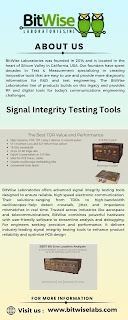Test Insertion Loss Methods
Insertion
loss is a critical concept in the world
of electrical and RF engineering. It refers to the loss of signal power that
occurs when a device, component, or network is inserted into a transmission
line or system. Engineers and designers frequently deal with insertion loss
when working on systems that involve signal transmission, such as communication
systems, RF networks, and data transfer applications.
Insertion loss refers to the
reduction of signal power that occurs when a component like a filter,
connector, or cable is inserted into a transmission line. Essentially, it’s a
measure of how much signal is lost as it travels through that component. This
loss can be due to several factors, including:
- Absorption:
Energy absorbed by the component's materials.
- Reflection:
Signals reflected back from impedance mismatches.
- Dissipation:
Loss of energy in the form of heat.
Insertion loss is typically measured
in decibels, where a higher dB
value represents greater loss. For example, an insertion loss of 0 dB means
that there’s no loss at all, while an insertion loss of 3 dB means that 50% of
the signal is lost as it passes through the component.
Test Insertion loss is a critical parameter in RF and electrical systems
because it directly impacts signal quality and system performance. High
insertion loss can lead to several issues, such as:
- Degraded Signal Quality: Higher insertion loss means that less of the signal
reaches its destination, which can result in reduced communication
quality, slower data rates, or poor performance in wireless networks.
- Increased Power Requirements: To compensate for insertion loss, systems may need to
transmit signals at higher power, which can lead to increased energy
consumption and potentially shorter component lifetimes.
- Performance Bottlenecks: In high-frequency systems, excessive insertion loss
can create bottlenecks, limiting the overall performance of the network.
By minimizing insertion loss,
engineers can improve signal integrity, reduce power consumption, and ensure
that systems operate efficiently. This is particularly important in industries
like telecommunications, aerospace, and data centers, where high-frequency
signals are common, and reliable signal transmission is critical.
Factors
Affecting Insertion Loss
Several factors can influence the
amount of insertion loss experienced in a system. These include:
- Component Quality:
Poor-quality materials and manufacturing processes can introduce greater
insertion loss. For example, low-grade connectors or cables can absorb or
reflect more signal energy.
- Frequency:
Insertion loss tends to increase with higher frequencies. As a result,
systems that operate in the microwave or millimeter-wave range are
particularly sensitive to insertion loss.
- Impedance Matching:
Impedance mismatches between components can cause reflections, which
increase insertion loss. Proper impedance matching is critical to
minimizing this effect.
- Length of the Component: The longer the transmission path, such as in cables,
the more loss is likely to occur. Minimizing the length of cables and
other transmission components can help reduce insertion loss.
Here’s how Bitwise Laboratories excels in the field:
- Advanced Network Analyzers: Bitwise Laboratories’ network analyzers are designed
for precise measurement of insertion loss. These tools provide accurate
results across a wide range of frequencies, making them ideal for
telecommunications, RF, and microwave applications.
- Automated Testing Solutions: With automation in insertion loss testing, Bitwise
Laboratories allows for more efficient testing procedures, reducing human
error and speeding up the testing process.
- Comprehensive Reporting: Their testing solutions offer detailed reporting
features, allowing engineers to analyze the results in-depth and make
data-driven decisions.
- Consultative Approach:
Bitwise Laboratories works closely with its clients to provide customized
testing solutions, ensuring that each system meets its unique performance
requirements.
Best Practices for Minimizing
Insertion Loss
To ensure optimal performance in
high-frequency systems, it’s essential to follow best practices for minimizing
insertion loss. Here are a few key strategies:
- Use High-Quality Components: Investing in high-quality cables, connectors, and
filters can significantly reduce insertion loss by minimizing signal
absorption and reflection.
- Ensure Proper Impedance Matching: Matching the impedance of each component in the
system is critical to reducing signal reflections and minimizing insertion
loss.
- Minimize Signal Path Length: Keeping transmission paths as short as possible helps
reduce the amount of signal lost along the way.
- Regular Testing and Maintenance: Regularly testing for insertion loss using
high-precision tools from Bitwise Laboratories can help identify
issues before they cause significant performance problems.
The Importance of Insertion Loss Testing
Test Insertion loss plays a crucial role in determining the efficiency and
reliability of high-frequency and RF systems. By understanding and testing
insertion loss, engineers can optimize signal transmission, improve system
performance, and minimize power consumption.
With the cutting-edge tools and
solutions provided by Bitwise
Laboratories, engineers can accurately measure and reduce insertion
loss, ensuring that their systems operate at peak efficiency. Whether working
in telecommunications, data centers, or RF applications, Bitwise Laboratories
offers the expertise and technology necessary for effective insertion loss
testing and system optimization.
For More Information
Visit us : www.bitwiselabs.com
.

.png)


Comments
Post a Comment